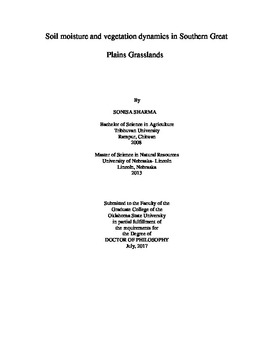| dc.contributor.advisor | Ochsner, Tyson E. | |
| dc.contributor.author | Sharma, Sonisa | |
| dc.date.accessioned | 2018-04-23T19:36:12Z | |
| dc.date.available | 2018-04-23T19:36:12Z | |
| dc.date.issued | 2017-07 | |
| dc.identifier.uri | https://hdl.handle.net/11244/299546 | |
| dc.description.abstract | This dissertation consists of three research projects aimed at better understanding grassland vegetation dynamics under drought and predicting vegetation dynamics using soil moisture and other vegetation parameters. The objective of the first project was to develop nondestructive methods of estimating aboveground biomass and fuel moisture content in our study area. We calibrated and validated both stepwise multiple linear regression (SMLR) and artificial neural network (ANN) models for Above-Ground Biomass (AGB) and Fuel Moisture Content (FMC) using data collected in grasslands near Stillwater, OK, USA. Our study spanned two growing seasons and nine patches located within three pastures under patch burn management. Day of year, canopy height, Normalized Difference Vegetation Index (NDVI), and percent reflectance at five spectral bands were candidate input variables for the models. For AGB, the ANN and SMLR models performed similarly (RMSE = 110 g m-2 versus 114 g m-2). For FMC, the ANN models proved better than SMLR models (RMSE = 23.3% versus RMSE = 27.7%). Given the large variability in the underlying datasets, these models may prove useful for nondestructive estimation of AGB and FMC in other similar grassland environments. The objective of the second study was to quantify the temporal dynamics of LFMC (live FMC), live fuel mass, dead fuel mass, and soil moisture expressed as fraction of available water capacity (FAW), and to describe how LFMC and live to dead fuel transition are related to FAW. LFMC exhibited a nonlinear, threshold-type relationship with FAW, with LFMC being insensitive to FAW at FAW levels above approximately 0.56 and positively related to FAW below that threshold. Live to dead fuel transitions occurred around a FAW value of approximately 0.34, with the rate of transition increasing linearly as FAW dropped below that threshold. In light of these findings and the increasing availability of soil moisture data, a logical next step would be to develop ways to incorporate soil moisture information into dynamic fuel bed models for improved fire danger assessments and enhanced wildfire preparedness. The objective of the third study was to evaluate the CROPGRO perennial forage model for simulating forage production and soil moisture in tallgrass prairie using the previously calibrated plant parameters from the literature. The uncalibrated forage model was not effective in estimating live mass but it was reasonably accurate in estimating the soil moisture. In light of this finding, the next step would be calibrating the model's plant parameters from the observed live mass data to allow improved prediction accuracy from the model. | |
| dc.format | application/pdf | |
| dc.language | en_US | |
| dc.rights | Copyright is held by the author who has granted the Oklahoma State University Library the non-exclusive right to share this material in its institutional repository. Contact Digital Library Services at lib-dls@okstate.edu or 405-744-9161 for the permission policy on the use, reproduction or distribution of this material. | |
| dc.title | Soil moisture and vegetation dynamics in Southern Great Plains grasslands | |
| dc.contributor.committeeMember | Alderman, Phillip D. | |
| dc.contributor.committeeMember | Rocateli, Alex Caldeira | |
| dc.contributor.committeeMember | Fuhlendorf, Samuel Dean | |
| osu.filename | Sharma_okstate_0664D_15365.pdf | |
| osu.accesstype | Open Access | |
| dc.type.genre | Dissertation | |
| dc.type.material | Text | |
| thesis.degree.discipline | Soil Science | |
| thesis.degree.grantor | Oklahoma State University | |
